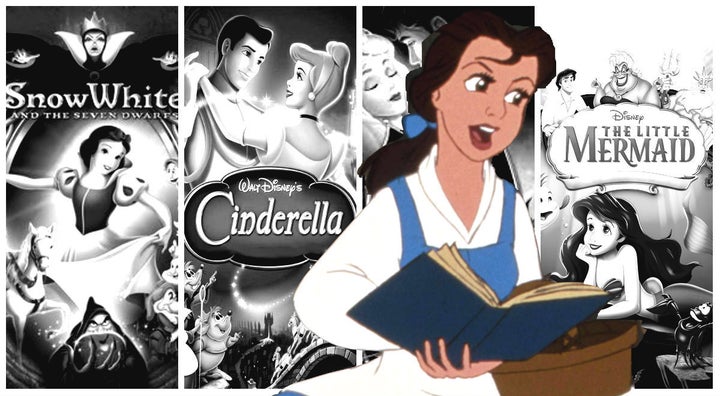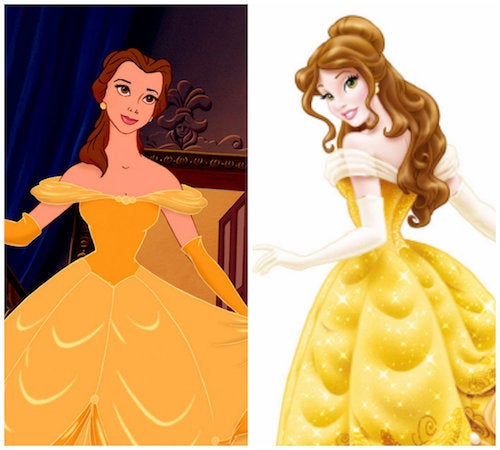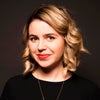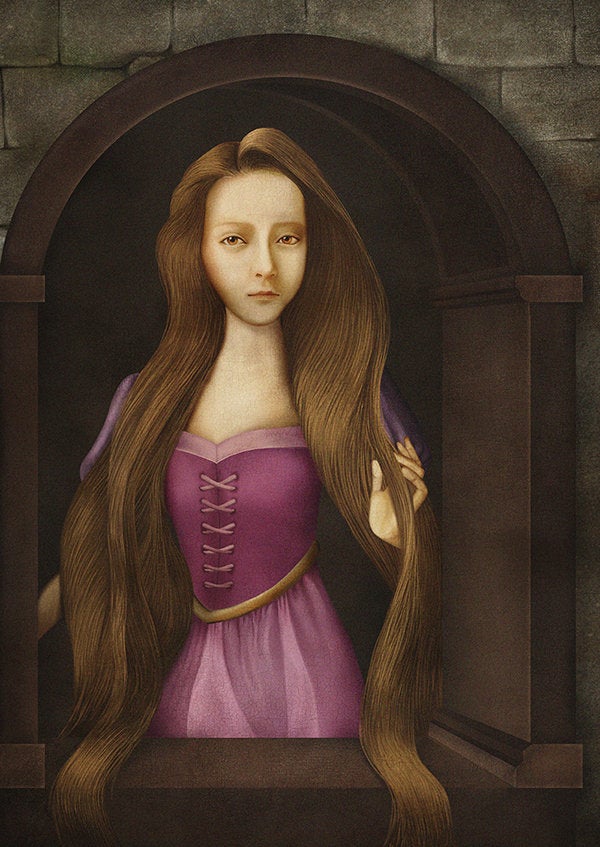
Looking back from a mountaintop of Elsa and Moana, it seems ridiculous that Ariel and Belle once struck Disney audiences as independent, tough, and feminist. But times can change quickly in children’s entertainment. Ariel and Belle were the stuff of my childhood. I was 10 by the time “Mulan” came out ― not too old to see and adore it, but old enough that it postdated my formative princess years. By the time films like “The Princess and the Frog,” “Tangled,” and “Brave” started to appear, I was long out of the target Disney demographic. When I was falling in love with “The Little Mermaid” and “Beauty and the Beast,” I wasn’t comparing them to “Mulan” and “Frozen,” obviously ― they didn’t exist yet. I was comparing them to “Sleeping Beauty” (blahsville), “Cinderella” (meh), and “Snow White” (nope).
It’s easy and, in many ways, valid to critique the feminism of films like “Beauty and the Beast” in hindsight. Twenty-five years after its debut, young people are still watching the movie, soaking up messages of mixed value, while the social context has changed and plenty of movies with independent, baggage-free heroines are now available. Is the movie a feminist manifesto? That seems like a reach. Is it a poisonous bit of anti-woman propaganda? Unclear.
Then again, I’m biased. “Beauty and the Beast” is the only movie I recall personally owning as a kid, on a VHS tape in a squeaky plastic case. I loved it. My dad touted Ariel, the heroine of “The Little Mermaid” (which actually premiered in 1989, the year after I was born), while I scoffed: Who could prefer the willingly silent, boy-obsessed mermaid princess over the bookish, brainy, self-possessed peasant girl? My favorite place was the local public library and, as my grandma will happily tell you, I was a stubborn, outspoken child; prying me away from my latest storybook and telling me to keep my opinions to myself were both losing propositions. When Belle steps into the Beast’s gleaming, palatial library, lined with stories-high bookshelves full of more novels than she could read in a lifetime, my head would spin with the romantic visions of a girl who grew up to follow Instagram accounts with names like “bookshelfporn.”
In her recent book, In Defense of the Princess: How Plastic Tiaras and Fairytale Dreams Can Inspire Strong, Smart Women, Jerramy Fine recalled similar feelings. “[T]he thing in this movie that really makes me swoon?” she wrote. “That library. When the Beast shows Belle those towering walls of floor-to-ceiling books, my heart flutters just as much as hers. And although the people in Belle’s hometown mock her constant thirst for knowledge, I love that through it all she remains an unabashed bookworm.”
Some critics counter that Belle’s reading is rarely shown in the film ― and that, unlike the practical, studious heroine of the most circulated version of the fairy tale, written by Jeanne-Marie Leprince de Beaumont in 1756, the movie Belle’s literary interests tend toward frivolous fiction, fairy tales with princes.
The Feminist Struggle To Make Belle More Than Just A Beauty
Still, even this version of Belle, who spends more time teaching the Beast to eat porridge with a spoon than lounging in his dream library with a stack of books, only appeared through determined effort. At least, that’s the contention of Linda Woolverton, who took over the script of “Beauty and the Beast” in 1988 after a number of pitches and treatments by other writers, including Jim Cox (“Oliver and Company”) and Gen LeRoy (“Walt Disney’s Wonderful World of Color”).
One treatment, crafted by British animators Richard and Jill Purdum, was scratched in 1988 after executives viewed some rough early reels and deemed it too lugubrious and dark. Once installed by Jeffrey Katzenberg, then the head of Disney’s motion picture division, to overhaul the script, Woolverton helped mold the sedate French fairy tale into a lively musical with a headstrong, yellow-clad heroine. Belle, she’s since said, was based in part on Katharine Hepburn’s character in the 1933 film “Little Women.”
“Woolverton’s fight to shape Belle into a new kind of Disney heroine was just that — a fight, every step of the way,” wrote Time’s Eliza Berman in May 2016. Her scripts took almost jaw-droppingly retrogressive rewrites:
In one scene, for example, Woolverton wrote Belle sticking pins into a map of all the places she wished to travel. By the time it got to storyboarding, Belle had been rewritten into a kitchen, decorating a cake. Woolverton protested, and the compromise that was reached had Belle with her nose in a book, a pastime at first considered too passive to be compellingly animated, which is why she always walks as she reads.
Roger Allers, the film’s story supervisor, told The Huffington Post he didn’t recall the conflict over cake decorating. “If that did happen, it must have been in the few weeks before I came on board the film,” he wrote in an email. He saw another cause behind the undermining rewrites Woolverton recalled: “The tension that existed between Linda and the story crew I think was due to her previous experience as a lone writer versus working in a collaborative group situation as was the tradition at Disney. In Story there, the script, indeed all visual ideas, are all open to review and revision in search of the best, most compelling way to tell a story. Nothing is sacred.” Not even an idealistic desire to show a princess seeking fulfillment outside of the kitchen or laundry room.
Some feminist critiques of “Beauty and the Beast” have, rightly, pointed out that the relentlessly vapid girls in the town (the Gaston fan club) serve as foils for Belle’s beauty and smarts ― implying that she is the only worthwhile woman around. “A common theme among Disney princess movies is to have the main character be isolated from other women, the rose among weeds,” noted Mari Rogers, who runs a Tumblr called Feminist Disney, in an email to HuffPost. There’s some evidence that “Beauty and the Beast” actually moved slightly away from this framing, though. A frequent tactic in earlier Disney films, right up to “The Little Mermaid,” was setting the heroine in direct opposition to a loathsome, typically older, female villain: Ursula, Cinderella’s wicked stepmother, the cruel queen of “Snow White” and the witch of “Sleeping Beauty.”
The Purdum adaptation of “Beauty and the Beast,” set in France in 1709, portrays such a character ― the sister of Maurice, who, as in the original fairy tale, is a poverty-stricken merchant. You can actually watch the choppily animated storyboards of the Purdum version’s first 20 minutes, with voiceovers, online:
In addition to a younger sister for Belle, the film featured their hateful aunt, who moves in with her brother Maurice, then a wealthy man, to help him care for his family ― and exploit him financially. When Maurice loses everything, his sister grows more and more shameless in her attempts to squeeze money out of her now-destitute brother and his family. In this write, Gaston is a wealthy and foppish suitor to whom Belle’s aunt schemes to marry her in order to open up a new pipeline of cash.
Once the Purdum script was tossed, Woolverton pushed for a version in which Belle’s interests and personal qualities come through more strongly ― and, incidentally, a version without the standard-issue bogeywoman.
A beautiful girl twirling through town with a romance novel, blissfully unencumbered with female family or friends, hardly seems the stuff of feminist revolutions ― but to see it as a positive nudge of the needle, we need only compare Belle to the previous drafts written of her by Disney creators, not to mention earlier heroines who spend most of their films asleep, voiceless, or uncomplainingly devoted to domestic drudgery. Disney’s Belle wasn’t an explosion of princess archetypes, but slight progress is still progress.
Woolverton seems well aware of the power even small changes can exert. “If you depict girls and women in these roles that we’ve never seen before,” she told Time, “then it becomes an assumption for younger generations.” Could Disney have ever moved straight from Aurora, the mostly snoozing heroine of “Sleeping Beauty,” to adventurous Merida of “Brave,” or bold Elsa of “Frozen”? Or was the normalization of Ariel, Belle, and Mulan necessary, to make a more spunky and self-possessed heroine seem not just normal, but an assumption?
The Beast Problem
Perhaps the most troubling message of “Beauty and the Beast,” for many feminist critics, lies not with Belle herself but with the Beast and his brute-force seduction. In an email to Huff Post, writer Peggy Orenstein blasted “the idea that the right woman can ‘tame’ a beastly, abusive, troubled man and turn him into a prince.” Orenstein, the author of Cinderella Ate My Daughter: Dispatches From the Front Lines of the New Girlie-Girl Culture, pointed out that both Belle’s and Ariel’s love stories contain unsettling lessons for girls about how women find partners and structure their lives. Belle’s role as the Victorian-esque angel in the house for her abusive counterpart is, she wrote, “an insidious message to girls, almost as insidious as the idea, in Disney’s version of ‘The Little Mermaid,’ that a woman would want to ― wait for it ― give up her voice to get a man. Deeply disturbing symbolism on both counts.” Rogers pointed out that Disney actually amped up this dynamic for the animated film: “In the original tale, the entire point of the story is that the beast’s scary appearance does not match his demeanor, which is consistently gentle and kind.”
That’s strike one and two for the Renaissance Disney princess films, which breathed new life into the genre after a 30-year Disney fairy tale hiatus prompted by the poor reception of “Sleeping Beauty” in 1959. Does this potentially toxic message about romance erase the gains made in crafting more ambitious, independent princesses?
Rogers doesn’t mince words about the risks of the narrative. “The love story in this one is one of the most disturbing ones in the princess lineup and rather regressive,” she wrote. “[The Beast] was undeniably verbally abusive — and used his stature to intimidate her.” What’s more, she argued, “The imprisonment adds a double layer of WTF to the situation. It perpetuates that ‘nice guy’ concept that if you can keep yourself in a woman’s company long enough/show her enough of yourself for long enough, she’ll eventually love you.”
Fine, conversely, resists the blanket condemnation of the films ― including the Belle/Beast relationship. Does the romance depict Stockholm Syndrome between a captor and his subdued victim, or an abusive relationship cycle? “I think it’s a stretch, and a tired one at that,” she told HuffPost in an email. “Because the true love story in this tale is about two marginalized people who find solace in each other.”
In the Beast, Fine sees a man who was never given a chance to love and accept himself: “Just as a child who is repeatedly told he is worthless will start believing it, the Beast has always been treated like a monster, and so after a while he started acting like one,” she wrote. “Belle is the first person in his life to see beyond this.” Meanwhile, she argues, Belle has more agency than simply a captive falling prey to distorted thinking. “Belle’s affection for him is not an irrational mental condition; rather it begins when she realises they are more alike than they are different (they’re both outsiders, they share the same values, the same love for books, etc.).” For what it’s worth, Woolverton also dismisses the argument that the relationship represents Stockholm Syndrome. “She was captured, but she transformed him,” she told IGN earlier this year. “She didn’t become, you know, an object.” Other critics, like Anna E. Altman and Gail de Vos, argue that, on the contrary, “there is nothing in the Beast for her to see until she puts it there.”
Through Fine’s pro-tiara lens, empowering messages gleam through all of the princess narratives (even that darn “Sleeping Beauty”). “I believe all Disney princess movies, and the classic fairy tales they are based on, are empowering for women,” she explained, “if we stop viewing them with a misogynistic lens and see them for what they are: actual narratives of female power and heroism.”
Her take on Belle’s romance with the Beast is a reassuring angle for fans, and there’s a gut logic to it that is likely to appeal to women who grew up with the movie ― though, of course, there lies the insidiousness of the message. “We’re just two crazy weirdos and no one understands us or our love” is a delicious ideal to embrace for one’s own relationship, as most teenagers know; but it can also mask serious problems. (Why do your friends seem uncomfortable with your boyfriend? Maybe you’re two dreamers who have found understanding only in each other ― or maybe your friends have noticed that he treats you like shit.) This narrative can allow us to downplay abusive behavior in the name of celebrating a unique and special love story. The Beast’s initially shocking behavior toward Belle “shouldn’t [be] acceptable just because she ‘chose’ to stay (not that she had much of an option) or because she vocalized her displeasure with it (and then he changed),” argues Rogers.
Watching the kids in the demographic for “Beauty and the Beast” engage with these films, though, it’s hard to grasp whether damaging ideas about romance really penetrate. When I was a little Belle fan, the Beast barely figured into my princess fantasy ― it was the sun-dappled, three-story-high bookshelves, the pretty clothes, and watching a girl onscreen who seemed so much like me (just, you know, much older and with eyes the size of saucers). Does the arguably abusive dynamic between Belle and the Beast have a real impact on young fans?
Brittney Lee Hamilton, who has worked for Disney and now performs for the party company Bella Princess as heroines including Belle, told HuffPost during a phone conversation that she’s found little girls usually pay the most attention to dress and hair color, and are looking more to identify directly with the heroines than to follow the romance. “They do understand that [Belle and the Beast have] a romantic relationship,” Hamilton said, but in terms of whether they’re really taking in the details of the love story, she’s less certain. “Watching the movies now as a woman,” Hamilton said, “you do see the messages … that it’s about looks and [...] who you fall in love with, that’s what makes your life. We see that, but I don’t think kids see that.” She also acknowledged that she and her colleagues actively try to counter harmful messages kids might receive from princess movies, such as that girls should concern themselves primarily with clothing and makeup, or that meeting and marrying a prince is the ultimate point of life.
After all, the acceptance of a romance based on unhealthy behavior, not to mention the idealization of heterosexual love and marriage, could be infiltrating nonetheless, even if kids seem outwardly impervious or, at least, uninterested. It might mean Disney’s relational narratives don’t have as direct and clear an impact as, say, that of Twilight, which is geared toward adolescent girls just discovering their taste for romance. Readers of the vampire teen romance saga notoriously tend to gush over the unique appeal of a boyfriend like chilly, carnivorous Edward Cullen. Meanwhile, women who specifically reference the Beast as their ideal mate are, in my experience, rare ― but they may fall into the same category as Edward Cullen’s fans: one film preparing girls’ minds for a certain kind of partner long before they were old enough to care about romance, the other franchise capitalizing on this quietly sown predisposition to create a teen idol who is also an inhuman outsider with barely suppressed urges of violence towards his beloved.
OK, that’s pretty specific, but it’s worth questioning whether the idealized yet abusive relationships portrayed in entertainment for very young kids might prime them to embrace the same dynamics in their entertainment, and their real lives, as they grow older. One study, published this summer, suggested that Disney princess films did have an influence on little girls ― “The more the girls in the study engaged with princess culture, the more they behaved in stereotypically feminine ways,” according to researchers. As for positive effects on little girls from watching the films? The study didn’t identify any.
Taking The Love Stories Out Of Fairy Tales
If kids don’t even care much about the romantic arcs in their movies, and the values put forward in their entertainment are likely to influence their malleable young minds, that raises an obvious question: Why make love stories for children’s entertainment to begin with, aside from a not ill-intentioned desire to make the films appealing to parents and others outside the tyke demographic?
Taking the romance out is a strategy Disney seems to have embraced with recent offerings ― even princessy ones ― as Slate’s Aisha Harris pointed out in a recent review of “Moana,” a new animated film that features a Polynesian girl on a mystical journey of self-discovery. “It was ‘Frozen’ in 2013 that marked a turning point for how Disney told its stories—and sold them,” writes Harris. The slightly earlier “Brave” (2012) abandoned the classic fairy tale format to tell the story of an adventurous young princess and her relationship with her mother; in “Frozen,” the romance-free twist went full Hans Christian Anderson, and the result was a smash hit. (Even if you think you know nothing about “Frozen,” you probably know half the words to “Let It Go,” the film’s most well-known and -karaoked song.) “The movie’s “Prince Charming–turned-villain and its explicit elevation of sisterhood over hetero romance felt revolutionary in the context of a Disney fairy tale,” writes Harris.
But that was in 2013, just as feminism was going celebrity mainstream. In the early ‘90s, the picture looked mighty different. “Beauty and the Beast” was just the second animated princess movie from Disney since the flop of “Sleeping Beauty,” a movie about a woman who is best described as “pretty” and “in a magically induced coma.” It’s hard to conceive, now, of a writer struggling to have a scene storyboarded of a female protagonist engaged in a hobby other than cake decorating; indeed, showing a heroine engaged in nothing but domestic tasks would seem hopelessly archaic. Merida was an archer; Mulan and Pocahontas, for all the failings of their respective films, were a warrior and an avid outdoorswoman. Tiana, of “The Princess and the Frog,” was likely to be found in the kitchen, but only because her dream is to open a restaurant. I asked Hamilton, who plays characters such as Ariel and Belle, who she performs as most often these days. “A lot of Elsa,” she said. “the ‘Frozen’ characters ― they dominate.”
Woolverton, who calls the earlier Disney princess movies “reflective of the culture” in an interview with EW, has emphasized that setting out to write a more feminist heroine in Belle proved to be “hard. You have to understand that the whole idea of the heroine-victim was baked into the cake, especially at Disney.” And even now, she said, she is satisfied with how the movie turned out. “I mean, you can only move the needle so much. Look at all the Disney princesses before her,” she pointed out. Belle “has an independent, open mind. She loves to read and to explore the outdoors. But even so, every day was a battle of making it happen,” she added. “Every single line of her dialogue was a battle.”
Tiny Steps of Progress
This sort of incrementalist approach, certain recent elections may have reminded us, can be infuriating to those who want change. Change over 25 years seems like an insufficient compromise ― why not fight for all that change, immediately? Or, hell, throw out the Disney princess brand machine altogether and build a feminist kids’ entertainment utopia elsewhere? Even when progress is inching forward, it can take the dreaded one-step-forward-two-steps-back route. More recent portrayals of Belle, argued Orenstein, have emphasized her beauty over her brains. In a 2012 redesign by Disney, she wrote, “Her appearance goes from forthright to flirty, from noble to hot.”

Looking at the last 25 years of Disney, though, a couple things are clear: One, a savvy media giant like Disney is too pervasive and persistent to blow up, especially if it’s willing to change to appeal to increasingly egalitarian and socially-aware young consumers. Two, investing in driving incremental change can be head-bangingly infuriating in the short term, yet produce impressive results years down the line.
Rogers expressed hope that a live-action movie would be able to improve upon the deeply problematic animated original. For one thing, she suggested, it would be great if Belle could be developed beyond an interest in travel and novels. “The fact that her father is an inventor (in a small provincial town ― what are the odds!) is intriguing,” she told HuffPost. “It would be interesting if Belle shared this interest.”
About that: Early in November, Emma Watson, who will play Belle in the upcoming live-action feature, offered a teaser about the character’s portrayal: “Yeah,” she told EW, “we made Belle an inventor.”
Hit Backspace for a regular dose of pop culture nostalgia.


